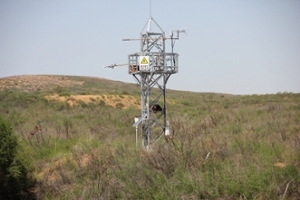Interannual variation in sap flow response in three xeric shrub species to periodic drought
Author: Sundas Iqbal, TIanshan Zha, Xin Jia, Muhammad Hayat, Duo Qian, Charles P. A. Bourque, Yun Tian, Yujie Bai, Peng Liu, Ruizhi Yang, Alamgir Khan
Posted on Mar 15, 2021
Category: Publications , Research
Abstract: Extreme seasonal droughts frequently occur in semiarid and arid areas of the world. They can exert a profound influence on the physiological state of desert plants. Short-term rainfall and long-term water shortages in the Mu Us Desert have differentiated the role of individual species with their distinct ability to resist and recover from drought. This study explores how the scale of rainfall events affects interannual variation in sap flow in three dominant desert-shrub species [i.e., Salix psammophila (SP), Artemisia ordosica (AO), and Hedysarum mongolicum (HM)], and whether the associated changes in soil-water dynamics helped to modify sap flow. As a result, interannual variation in sap flow (Js) was mostly driven by precipitation (PPT), Volumetric soil water content (VWC), and leaf area index (LAI), with their individual influences varying as a function of plant phenophases. The species acclimated to long-term summer drought (> 30 days, i.e., no rain over a 30-day period or longer) by reducing stomatal conductance in the three species by 66.5, 59.5, and 43.5%, respectively, suggesting a physiological adjustment in water conservation in response to drought. Average summer drought (June–July) reduced Js in the three species by 55.5 (in SP), 42 (AO), and 28.5% (HM), more than spring drought (May–June) at 28% in SP and 9.5% in AO. Among those species, HM exhibited the least sensitivity and the highest overall resistance and resilience to drought. The relationship between Js and VWC was modulated by the effect of PPT. Our findings provide compelling evidence that HM is seen to be better suited to future climatic warming, as the species may be capable of accessing deep groundwater reserves replenished by large PPT pulses (5–10 mm), in sustaining its physiological activity over longer periods. These results could help formulate a selection process in determining which shrub species to plant in the sustainable management of desert ecosystems.
Authors: undas Iqbalab, TIanshan Zhaab, Xin Jiaab , Muhammad Hayatab , Duo Qianc, Charles P. A. Bourquead, Yun Tianab, Yujie Baiab, Peng Liuab, Ruizhi Yangab, Alamgir Khanab
Author affiliations:a Yanchi Research Station, School of Soil and Water Conservation, Beijing Forestry University, Beijing, 100083, China
bBeijing Engineering Research Center of Soil and Water Conservation, Beijing Forestry University, Beijing, China
cBeijing Vocational College of Agriculture, Beijing, 102442, China
dFaculty of Forestry and Environmental Management, 28 Dineen Drive, University of New Brunswick, Fredericton, New Brunswick, E3B 5A3, Canada
To read the entire article go to doi: https://doi.org/10.1016/j.agrformet.2020.108276

